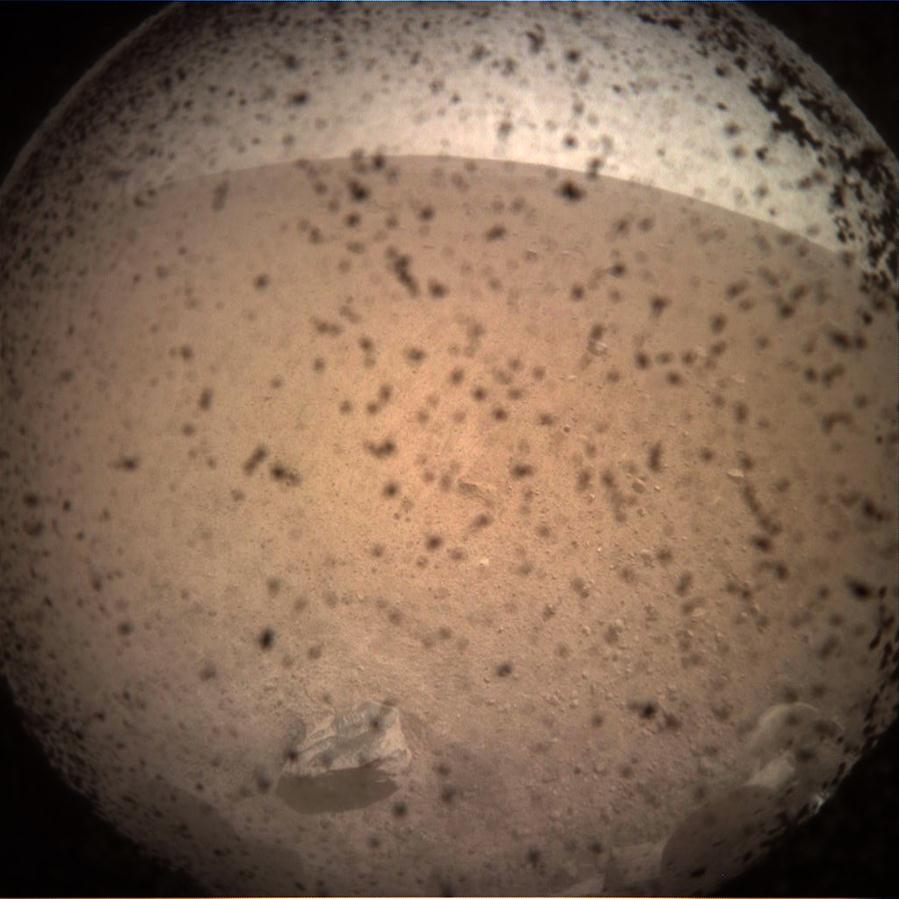


Photo provided by NASA on Nov. 26, 2018 shows the first image taken by NASA's InSight lander on the surface of Mars after its landing. NASA's InSight spacecraft touched down safely on Mars on Monday, kicking off a two-year mission to explore the deep interior of the Red Planet. (Xinhua/NASA/JPL-CALTECH)
LOS ANGELES, Nov. 26 (Xinhua) -- NASA's InSight spacecraft touched down safely on Mars on Monday, kicking off a two-year mission to explore the deep interior of the Red Planet.
NASA's online live broadcast reported InSight touched down on Mars at approximately 2:54 p.m. EST (1954 GMT) on Monday, after a six-month, 300-million-mile (480-million-km) journey.
The lander plunged through the thin Martian atmosphere at about 2:47 p.m. EST (1947 GMT), heatshield first, and used a supersonic parachute to slow down. Then, it fired its retro rockets to slowly descend to the surface of Mars, and landed on the smooth plains of Elysium Planitia.
InSight is being followed to Mars by two mini-spacecraft comprising NASA's Mars Cube One (MarCO), the first deep-space mission for CubeSats which attempt to relay data from InSight as it enters the planet's atmosphere and lands.
At about 3 p.m. EST (2000 GMT), MarCO sent back the first picture of Mars.
InSight will detect geophysical signals deep below the Martian surface, including marsquakes and heat. Scientists will also be able to track radio signals from the stationary spacecraft, which vary based on the wobble in Mars' rotation, according to NASA.
InSight and MarCO flight controllers monitored and cheered for the spacecraft's successful entry, descent and landing from mission control at NASA's Jet Propulsion Laboratory in Pasadena, California.
It took the InSight team about four to five years to design and execute the mission, said an engineer at the mission control.
He said the basic design of InSight was inherited from Phoenix spacecraft, which landed on Mars on May 25, 2008.
To look deep into Mars, the lander must be at a place where it can stay still and quiet for its entire mission. That's why scientists chose Elysium Planitia as InSight's home, according to NASA.
The red planet is comparatively easy to land on and is less likely to melt our equipment than Venus or Mercury, according to NASA.
Launched on May 5, InSight marks NASA's first Mars landing since the Curiosity rover in 2012 and the first dedicated to studying the deep interior of Mars.

 Award-winning photos show poverty reduction achievements in NE China's Jilin province
Award-winning photos show poverty reduction achievements in NE China's Jilin province People dance to greet advent of New Year in Ameiqituo Town, Guizhou
People dance to greet advent of New Year in Ameiqituo Town, Guizhou Fire brigade in Shanghai holds group wedding
Fire brigade in Shanghai holds group wedding Tourists enjoy ice sculptures in Datan Town, north China
Tourists enjoy ice sculptures in Datan Town, north China Sunset scenery of Dayan Pagoda in Xi'an
Sunset scenery of Dayan Pagoda in Xi'an Tourists have fun at scenic spot in Nanlong Town, NW China
Tourists have fun at scenic spot in Nanlong Town, NW China Harbin attracts tourists by making best use of ice in winter
Harbin attracts tourists by making best use of ice in winter In pics: FIS Alpine Ski Women's World Cup Slalom
In pics: FIS Alpine Ski Women's World Cup Slalom Black-necked cranes rest at reservoir in Lhunzhub County, Lhasa
Black-necked cranes rest at reservoir in Lhunzhub County, Lhasa China's FAST telescope will be available to foreign scientists in April
China's FAST telescope will be available to foreign scientists in April